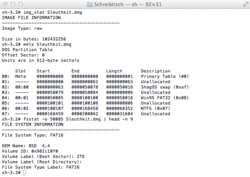This article needs additional citations for verification .(August 2016) |
| The Sleuth Kit | |
|---|---|
 | |
| Original author | Brian Carrier |
| Stable release | 4.14.0 / 15 April 2025 |
| Repository | |
| Written in | C, Perl |
| Operating system | Unix-like, Windows |
| Type | Computer forensics |
| License | IPL, CPL, GPL |
| Website | www |
The Sleuth Kit (TSK) is an open-source library and collection of utilities for Unix-like operating systems and Windows that is used for extracting and parsing data from disk drives and other computer data storage devices so as to facilitate the forensic analysis of computer systems. It forms the foundation for Autopsy, a better known tool that is essentially a graphical user interface to the command line utilities bundled with The Sleuth Kit. [1] [2]
Contents
The software is under active development and it is supported by a team of developers. The initial development was done by Brian Carrier [3] who based it on The Coroner's Toolkit. It is the official successor platform. [4]
The Sleuth Kit is capable of parsing NTFS, FAT, ExFAT, UFS versions 1 and 2, Ext2, Ext3, Ext4, HFS, ISO 9660 and YAFFS2 file systems either on disk or within whole disk or disk partition images stored in raw form (as can be obtained with dd), or Expert Witness or AFF formats. [5] The Sleuth Kit can be used to examine the contents of most computers that run Microsoft Windows, macOS, or Linux and some other computers which run derivatives of Unix such as the BSDs or Solaris.
The Sleuth Kit can be used via the included command line tools, or as a library embedded within a separate digital forensic tool such as Autopsy or log2timeline/plaso.